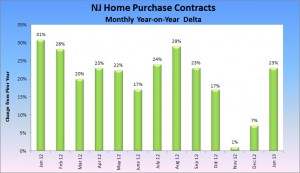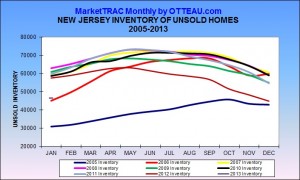From the Otteau Group:
NJ Contract-Sales Activity Starts Off Strong in 2013
Following 2 consecutive months of single digit gains, home purchase activity in New Jersey soared in January with a 23% y-o-y increase in signed purchase-contracts. The smaller gains in November and December were attributable to after-effects of Hurricane Sandy. What makes this rise especially impressive is that it occurred so early in the year, signaling an early start to the seasonal Spring surge in home purchase demand. Considering that purchase-contracts recorded a 31% y-o-y increase in January-2012, demand has increased by an astounding 61% over the past 2 years.
Shifting to the supply side of the equation, unsold inventory began the year at its lowest level since the housing crisis began in 2006.Unsold Inventory in the state has declined by 19% since January of last year, equating to 11,000 fewer homes on the market. The current level of Unsold Inventory equates to 8.1 months of sales (non-seasonally adjusted) compared to 12.3 months one year ago. Expect the home purchase market to continue to strengthen despite the cloud of sequestration that is currently hanging over Washington. That mortgage interest rates have drifted slightly higher recently is likely to accelerate this trend as buyers rush to take advantage of lower rates.
Further evidence of the housing rebound comes from rising home prices. After lagging the rest of the nation, home prices in New Jersey increased in the 4th quarter of 2012 by 2.91%. This follows steady improvement in the home purchase market over the past 18 months, and marks the first home price increase in the state since the 4th quarter of 2010.
A separate analysis in Northern New Jersey has indicated that home prices have held up better in northern New Jersey towns with train station service to Manhattan. Since peaking in 2006, the decline in commuter towns like Glen Rock and Ridgewood has been about half as much compared to other drivable-suburban places. This dynamic is consistent with a European model for housing demand wherein transportation efficiencies are of increasing importance.


